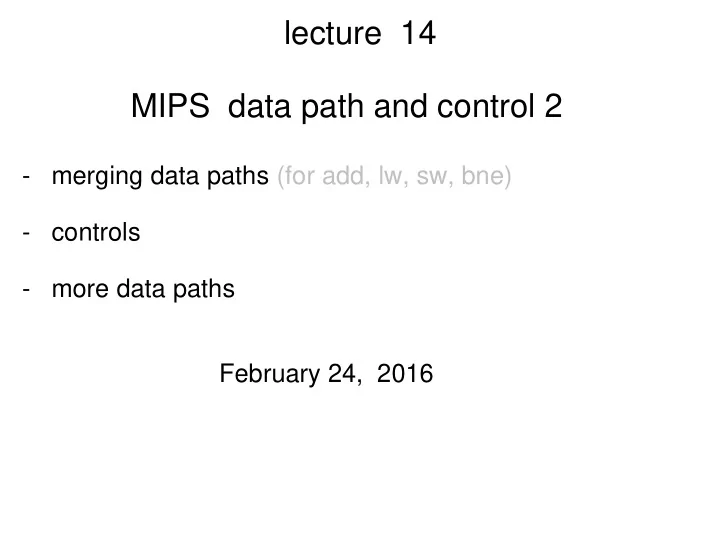

lecture 14 MIPS data path and control 2 - merging data paths (for add, lw, sw, bne) - controls - more data paths February 24, 2016
Let's look at the controls on the previous slide.
For more details on the combinational circuit used to compute mapping on the previous slide, you would need to consult standard textbook by Patterson and Hennessey. However, if you do, you will find that I'm defining ALUop in a more simplified way from what is done in the book. They use two combinational circuits: one for the instructions with opcode 000000 and funct field, and one for instructions with other opcodes.
Branching - conditional: bne, beq - unconditional - jump ( "j" ) - jump and link ( "jal") - jump register ("jr") In each case, we need to determine the next value of the program counter (PC) and possibly do other stuff.
Here we merge the add/etc, lw, sw, bne datapaths. We introduce a PCSrc control.
Jump and link ( "jal" ) is used for function calls. (Recall lecture 11. See Assignment 3.) What is its datapath ?
What does "jump register" ( jr $ra ) do ? It is used to return from function calls: (lecture 11 and Assignment 3)
PCsrc control is used to select the address of the next instruction to be executed.
WARNING Single Cycle Model (last two lectures) is not used in real MIPS implementations. Why not? - inefficient : each clock cycle must be long enough for worst case (Which instruction has longest data path on CPU ?) - multiplication, division, floating point ops (co-processor 1) also require more than 1 clock cycle After the Study Break, I will sketch out the "multicycle" model that MIPS CPU's do use.
MARS DEMO Recursive function calls and stack Use example of sumton from lecture 11. I have added a link to the code: http://www.cim.mcgill.ca/~langer/273/sumton.asm FIRST REVIEW ALGORITHM
sumton: # if n == 0 then branch to base case # else push the two items onto the stack: # return address ($ra) # argument n ($a0) # # compute argument (n-1) for next call # jump and link to sumton # load the return address (pop) # load argument from the stack (pop) # change the stack pointer # register $v0 contains result of sumton(n-1) # add argument n to $v0 # return to parent basecase: # assign 0 as the value in $v0 # return to parent
Assignment 3 Given a list of N integers, return the one that is "of rank k", that is, the integer that would be at index k in a sorted version of the list. Let L be the list. Choose an element from L and call it "pivot". Partition the list into three lists: L1, L2, L3 such that: - L1 contains all the elements less than pivot - L2 contains all the element equal to pivot - L3 contains all the elements greater than pivot. What then? (recursion) Which data structure to use for L1, L2, L3 ?
Announcements - A2 grading scheme (small change) - Quiz 3 and yellow stickies (mean ~70%) - due date for A3 is Wed after study break
Recommend
More recommend